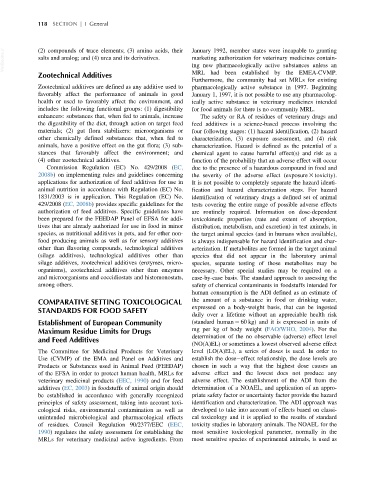Page 151 - Veterinary Toxicology, Basic and Clinical Principles, 3rd Edition
P. 151
118 SECTION | I General
VetBooks.ir (2) compounds of trace elements; (3) amino acids, their January 1992, member states were incapable to granting
marketing authorization for veterinary medicines contain-
salts and analog; and (4) urea and its derivatives.
ing new pharmacologically active substances unless an
Zootechnical Additives MRL had been established by the EMEA-CVMP.
Furthermore, the community had set MRLs for existing
Zootechnical additives are defined as any additive used to pharmacologically active substance in 1997. Beginning
favorably affect the performance of animals in good January 1, 1997, it is not possible to use any pharmacolog-
health or used to favorably affect the environment, and ically active substance in veterinary medicines intended
includes the following functional groups: (1) digestibility for food animals for there is no community MRL.
enhancers: substances that, when fed to animals, increase The safety or RA of residues of veterinary drugs and
the digestibility of the diet, through action on target feed feed additives is a science-based process involving the
materials; (2) gut flora stabilizers: microorganisms or four following stages: (1) hazard identification, (2) hazard
other chemically defined substances that, when fed to characterization, (3) exposure assessment, and (4) risk
animals, have a positive effect on the gut flora; (3) sub- characterization. Hazard is defined as the potential of a
stances that favorably affect the environment; and chemical agent to cause harmful effect(s) and risk as a
(4) other zootechnical additives. function of the probability that an adverse effect will occur
Commission Regulation (EC) No. 429/2008 (EC, due to the presence of a hazardous compound in food and
2008b) on implementing rules and guidelines concerning the severity of the adverse effect (exposure 3 toxicity).
applications for authorization of feed additives for use in It is not possible to completely separate the hazard identi-
animal nutrition in accordance with Regulation (EC) No. fication and hazard characterization steps. For hazard
1831/2003 is in application. This Regulation (EC) No. identification of veterinary drugs a defined set of animal
429/2008 (EC, 2008b) provides specific guidelines for the tests covering the entire range of possible adverse effects
authorization of feed additives. Specific guidelines have are routinely required. Information on dose-dependent
been prepared for the FEEDAP Panel of EFSA for addi- toxicokinetic properties (rate and extent of absorption,
tives that are already authorized for use in food in minor distribution, metabolism, and excretion) in test animals, in
species, as nutritional additives in pets, and for other non- the target animal species (and in humans when available),
food producing animals as well as for sensory additives is always indispensable for hazard identification and char-
other than flavoring compounds, technological additives acterization. If metabolites are formed in the target animal
(silage additives), technological additives other than species that did not appear in the laboratory animal
silage additives, zootechnical additives (enzymes, micro- species, separate testing of those metabolites may be
organisms), zootechnical additives other than enzymes necessary. Other special studies may be required on a
and microorganisms and coccidiostats and histomonostats, case-by-case basis. The standard approach to assessing the
among others. safety of chemical contaminants in foodstuffs intended for
human consumption is the ADI defined as an estimate of
COMPARATIVE SETTING TOXICOLOGICAL the amount of a substance in food or drinking water,
STANDARDS FOR FOOD SAFETY expressed on a body-weight basis, that can be ingested
daily over a lifetime without an appreciable health risk
Establishment of European Community (standard human 5 60 kg) and it is expressed in units of
Maximum Residue Limits for Drugs mg per kg of body weight (FAO/WHO, 2004). For the
determination of the no observable (adverse) effect level
and Feed Additives
(NO(A)EL) or sometimes a lowest observed adverse effect
The Committee for Medicinal Products for Veterinary level (LO(A)EL), a series of doses is used. In order to
Use (CVMP) of the EMA and Panel on Additives and establish the dose effect relationship, the dose levels are
Products or Substances used in Animal Feed (FEEDAP) chosen in such a way that the highest dose causes an
of the EFSA in order to protect human health, MRLs for adverse effect and the lowest does not produce any
veterinary medicinal products (EEC, 1990) and for feed adverse effect. The establishment of the ADI from the
additives (EC, 2003) in foodstuffs of animal origin should determination of a NOAEL, and application of an appro-
be established in accordance with generally recognized priate safety factor or uncertainty factor provide the hazard
principles of safety assessment, taking into account toxi- identification and characterization. The ADI approach was
cological risks, environmental contamination as well as developed to take into account of effects based on classi-
unintended microbiological and pharmacological effects cal toxicology and it is applied to the results of standard
of residues. Council Regulation 90/2377/EEC (EEC, toxicity studies in laboratory animals. The NOAEL for the
1990) regulates the safety assessment for establishing the most sensitive toxicological parameter, normally in the
MRLs for veterinary medicinal active ingredients. From most sensitive species of experimental animals, is used as

